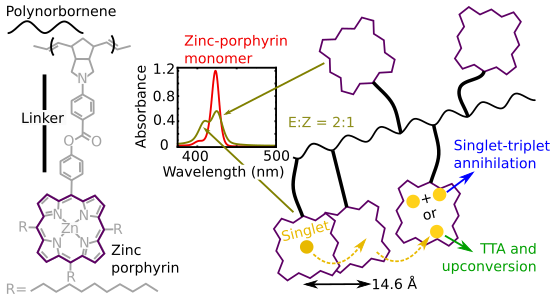
Paper published in J. Phys. Chem. A
Spectroscopic and dynamic properties of electronically excited pendant porphyrin polymers with backbones of differing flexibility
Amy L. Stevens, Stephen Awuku, Kenneth P. Ghiggino, Ying Hao, Sacha Novakovic, Ronald P. Steer, and Jonathan M. White
A zinc porphyrin-pendant norbornene polymer with a rigid backbone characterized by a 2:1 E/Z isomeric structure ratio has been synthesized, and its spectroscopic and photophysical properties are examined. Zinc tetraphenylporphyrin, the porphyrin-substituted norbornene monomer, and a previously reported zinc porphyrin-pendant polymer with a flexible polymethylene backbone have been used as comparators. Unlike its flexible counterpart, the rigid norbornene polymer exhibits clear exciton splitting of its Soret band, much more rapid relaxation rates of its excited singlet states, and a very small yield of an unusually short-lived triplet state. Unlike the flexible pendant polymer, which exhibits excimeric S2 fluorescence as a result of chromophore rotation, anti-Kasha emission from the norbornene polymer originates primarily from the unperturbed porphyrin E region. The low triplet yield in the polymer is attributed to greatly increased rates of competing internal conversion within the singlet manifold. Nevertheless, upconverted delayed fluorescence that is quenched by oxygen is observed upon intense steady-state Q-band excitation of degassed polymer solutions, signaling direct triplet involvement. Consistent with the polymer’s rigid structure, this biexcitonic process is assigned to ultrafast singlet exciton migration and triplet–triplet annihilation following absorption of a second photon by the small steady-state concentration of polymer triplets.

